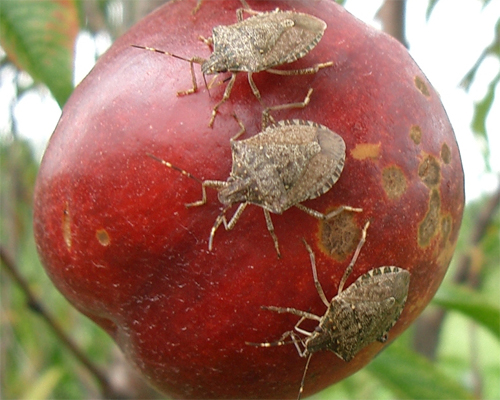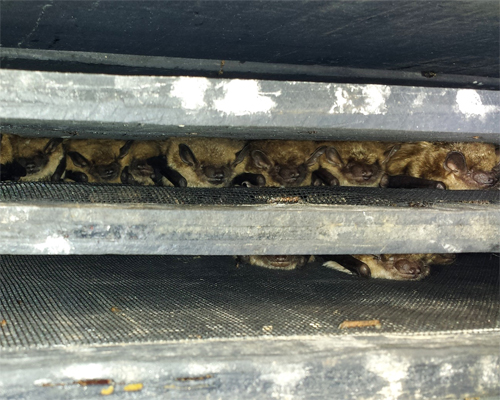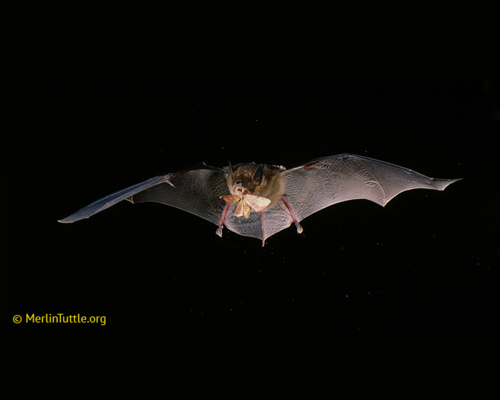
Fact Sheet FS1270
Agricultural insect pests cost the U.S. agricultural industry $33 billion per year in crop losses, and destroy approximately 25–50% of crops worldwide. This trend continues despite an increased use of pesticides in recent decades on farms throughout the world. Broad-spectrum pesticides are dangerous to human health, degrade ecosystem function, upset carefully optimized integrated pest management (IPM) programs, and devastate natural insect predators and parasitoids. In addition, the World Resources Institute estimates that up to 400 agricultural pest species may have evolved some degree of pesticide resistance.
One effort to limit pesticide includes the use of biological control agents, which are living organisms that prey upon pest species. While proven effective in some cases, biological control comes with significant economic costs and typically offers only partial control. Biological control agents are typically non-native species and may have long-lasting negative effects on native biodiversity.
Native generalist predators can effectively serve as agents of biological control. Temperate insectivorous bats are highly effective generalist predators, and studies have documented the presence of many agricultural pest species in their diet. Especially during the summer months, when bats are raising young, female bats consume a significant proportion of their body weight in insects per day. Because they feed within a few kilometers of their roost site and return to the same roost every day, bats may play an important role in local suppression of agricultural insect pests.
What Do Bats Eat?
Identifying the insect prey of bats is challenging. Historically, biologists analyzed bat fecal and stomach contents, which involved visually identifying undigested insect fragments. Recently, molecular techniques have allowed identification of insect DNA from bat feces (guano), providing much better information about what a bat eats.
We now know that the majority of a bat's diet consists of moths (lepidopterans), beetles (coleopterans), flies (dipterans), cicadas and leaf hoppers, and true bugs (hemipterans). These orders of arthropods include many important agricultural insect pest species. Some prominent examples include corn earworm moth (Helicoverpa zea), cotton bollworm (Helicoverpa zea), spotted cucumber beetle (Diabrotica undecimpunctata), western corn rootworm (Diabrotica virgifera), and three stinkbug species: green stinkbug (Acrosternum hilare), brown stink bug (Euschistus servus), and brown-marmorated stinkbug (Halyomorpha halys). A detailed list of insect pests in New Jersey known to be consumed by bats is included in Table 1.
| Insect Pest - Latin Name | Insect Pest - Common Name | Bat Species That Consumes Pest | Affected Crops |
|---|---|---|---|
| Abagrotis alternata | mottled gray cutworm | eastern red bat (Lasiurus borealis) northern long-eared bat (Myotis septentrionalis) |
potato, tomato, tree fruit, strawberry |
| Abagrotis ipsilon | black cutworm | eastern red bat | field corn, sweet corn, tobacco, turf grass, wheat |
| Acleris flavivittana | masked leaf roller moth | big brown bat little brown bat (Myotis lucifugus) |
roses, apples, pin cherries |
| Acleris semipurpurana | oak leaf tier | big brown bat little brown bat |
pin cherries |
| Acrosternum hilare (Chinavia hilaris) | green stink bug | big brown bat (Eptesicus fuscus) eastern red bat hoary bat (Lasiurus cinereus) Indiana bat (Myotis sodalis) |
wide variety of vegetable crops, grains, pome fruits, stone fruits |
| Agnetina capitate | Mediterranean fruit fly | little brown bat | fruit |
| Agriphila vulgivagellus | vagabond crambus moth | big brown bat little brown bat |
corn |
| Agrotis ipsilon | dark-sword grass moth | big brown bat | vegetables, grains |
| Ambrosiodmus tachygraphus | bark beetle | big brown bat | peaches, chestnut trees |
| Ambrosiophilus atratus | ambrosia beetle | big brown bat | hardwood trees |
| Amphipyra pyramidoides | copper underwing | big brown bat | blueberries |
| Anagrapha falcifera | celery looper | eastern red bat | celery, lettuce |
| Apamea amputatrix | yellow-headed cutworm | eastern red bat | grasses, vegetables |
| Apamea devastator | glassy cutworm | eastern red bat | cereals, corn, grasses |
| Aptinothrips rufus | thrips | big brown bat | cotton, cereals |
| Archips cerasivorana | ugly-nest caterpillar moth | eastern red bat | trees (particularly aspen, birch and fruit) |
| Archips purpurana | omnivorous leafroller | big brown bat little brown bat |
apples |
| Archips semiferanus | oak leafroller moth | eastern red bat big brown bat |
oak trees |
| Astylopsis sexguttata | woodboring beetle | big brown bat | hardwood trees |
| Automeris io | Io moth | big brown bat | cotton, berries, oak, sassafras, pear, rose |
| Blastobasis glandulella | acorn moth | big brown bat little brown bat |
acorns |
| Caloptilia coroniella | fall armyworm | little brown bat | birch trees, aspen trees |
| Chrysoteuchia topiarius | cranberry girdler | eastern red bat | cranberry, cool-season grasses |
| Clepsis peritana (Ptycholoma peritana) | garden tortrix | northern long-eared bat | strawberry |
| Conotrachelus anaglypticus | cambium curculio | big brown bat | orchard fruits |
| Crambus praefectellus | silver-striped webworm | eastern red bat | turf grasses, cereal grains |
| Culicidae | mosquitoes | Indiana bat | n/a |
| Curculio proboscideus | primitive weevil | big brown bat | hazelnuts |
| Cyclocephala borealis | northern masked chafer | big brown bat | turf grasses, corn |
| Cydia caryana | hickory shuckworm moth | big brown bat | pecans |
| Cydia latiferreana | filbertworm moth | big brown bat | hazelnut |
| Cydia pomonella | codling moth | big brown bat | pome fruit, stone fruit, walnuts |
| Cyrtepistomus castaneus | Asiatic oak weevil | big brown bat eastern red bat Indiana bat |
oak trees, chestnut trees |
| Dermestes lardarius | larder beetle | big brown bat | stored grains |
| Desmia funeralis | grape leaffolder moth | little brown bat | grapes |
| Diabrotica undecimpunctata | spotted cucumber beetle | big brown bat Indiana bat little brown bat |
cultivated crops, flowers, cucumbers, squash, corn, soybean, cotton, beans |
| Diabrotica virgifera | western corn rootworm | big brown bat | corn |
| Dibolia borealis | plantain flea beetle | big brown bat | plantains |
| Dichomeris ligulella | palmerworm moth | big brown bat little brown bat |
apples, cherries |
| Drosophila spp. | fruit flies | eastern red bat big brown bat little brown bat |
fruits, turfgrasses |
| Drosophila suzukii | fruit fly | big brown bat little brown bat |
berries, cherries, grapes, tree fruits |
| Eucopina tocullionana | white pine cone borer | big brown bat | pine trees, seed orchards |
| Eumorpha pandorus | pandora sphinx | big brown bat | grapes |
| Euschistus servus | brown stink bug | big brown bat northern long-eared bat |
wide variety of cultivated crops, grains, pome fruits, stone fruits |
| Euxoa tessellate | tessellate dart moth | eastern red bat | pome and stone fruit, tobacco |
| Exomala orientalis | Oriental beetle | big brown bat little brown bat |
turfgrass, fruits |
| Frankliniella tritici | eastern flower thrips | big brown bat little brown bat |
cotton, vegetables |
| Grapholita molesta | oriental fruit moth | big brown bat | stone fruit |
| Gyponana spp. | Homoptera | big brown bat little brown bat |
hickory trees, grapes |
| Halyomorpha halys | brown marmorated stink bug | big brown bat | citrus, pome fruits, field corn, vegetables, soybeans |
| Harpalus caliginosus | murky ground beetle | big brown bat | strawberries |
| Harpalus pensylvanicus | PA dingy ground beetle | big brown bat little brown bat |
strawberries |
| Hypena scabra | green cloverworm | eastern red bat big brown bat |
corn, legumes |
| Japanagromyza viridula | oak shothole leafminer | big brown bat | oak trees |
| Keiferia lycopersicella | tomato pinworm | big brown bat | tomato |
| Lacanobia subjuncta | speckled cutworm | eastern red bat | berries, cultivated crops, pome fruit, stone fruit |
| Lygus convexicollis | plant bug | big brown bat | strawberries, alfalfa |
| Lygus lineolaris | tarnished plant bug | big brown bat little brown bat |
cotton |
| Lymantria dispar | gypsy moth | eastern red bat | hardwood trees, cranberry |
| Malacosoma americana | eastern tent caterpillar | eastern red bat big brown bat |
various hardwood tree species |
| Malacosoma disstria | forest tent caterpillar | big brown bat little brown bat |
orchards |
| Mayetoila destructor | hessian fly | Indiana bat | wheat |
| Megacyllene robiniae | locust borer beetle | big brown bat | black locust tree |
| Melanotus spp. | click beetle | big brown bat little brown bat |
turfgrasses, multiple agricultural crops |
| Metcalfa pruinosa | citrid flatid planthopper | big brown bat little brown bat |
orchards, vineyards |
| Mompha stellella | momphid moth | little brown bat | seed crops |
| Mythimna unipuncta (Pseudaletia unipuncta) | armyworm moth | eastern red bat big brown bat little brown bat |
hay, barley, corn, oats, grass |
| Myzus persicae | green peach aphid | little brown bat | vegetables |
| Noctua pronuba | large yellow underwing | eastern red bat | cultivated crops, grasses, ornamental plants |
| Orgyia leucostigma | white-marked tussock moth | little brown bat | oak trees, maple trees |
| Oxidus gracilis | greenhouse millipede | big brown bat | potatoes, sugar, beets, carrots, sweet potatoes, strawberries, peas, beans |
| Pandemis lamprosana | woodgrain leafroller moth | big brown bat | orchards |
| Parapediasia teterrellus | bluegrass webworm moth | eastern red bat little brown bat big brown bat |
turf grasses |
| Paria fragariae | strawberry rootworm | little brown bat | apple, peach, soybeans, corn, rye, oats, grapes |
| Patalene olyzonaria | juniper twig geometer | big brown bat | juniper trees, cedar trees |
| Peridroma saucia | variegated cutworm | eastern red bat | vegetables, legumes, corn, alfalfa |
| Philaenus spumarius | meadow spittlebug | big brown bat | clover, alfalfa |
| Phyllophaga anxia | cranberry white grub | big brown bat | softwood trees, hardwood trees |
| Phyllophaga spp. | scarab/may beetle | big brown bat little brown bat |
hardwood trees, soft wood trees, pome fruit, stone fruit, sweet potatoes |
| Phytocoris conspurcatus | plant bug | big brown bat | fruits |
| phytocoris eximius | plant bug | big brown bat | pistachios |
| Phytomyza gymnostoma | leaf miner | big brown bat | leeks, scallions, onions |
| Platynota flavedana | black-shaded platynota moth | big brown bat | apples |
| Platynota idaeusalis | tufted apple bud moth | big brown bat little brown bat |
pome fruit, stone fruit, various trees |
| Plodia interpunctella | Indian meal moth | eastern red bat | stored grain |
| Prionoxystus robiniae | locust borer | big brown bat | hardwood |
| Proteoteras crescentana | twig borer moth | little brown bat | box elder maple trees |
| Proteoteras moffatiana | maple shoot borer | big brown bat | maple trees |
| Proxenus miranda | glistening rustic moth | big brown bat | cantaloupes, sugar beets, strawberries, sweet potatoes |
| Sitotroga cerealella | angoumois grain moth | big brown bat little brown bat |
grains |
| Sonia constrictana | constricted sonia moth | big brown bat | maple trees |
| Sparganothis sulfureana | fruitworm moth | big brown bat little brown bat |
cranberries |
| Stegobium paniceum | bread beetle/drugstore beetle | little brown bat | dried tobacco, dried what crops |
| Stenolophus lineola | seedcorn beetle | big brown bat little brown bat |
corn |
| Stenotus binotatus | plant bug | little brown bat | grasses, wheats |
| Sunira bicolorago | bicolored sallow | big brown bat | cabbage, tobacco |
| Taniva albolineana | spruce needleminer moth | little brown bat | spruce trees |
| Taylorilygus apicalis | broken backed plant bug | big brown bat little brown bat |
hardwood trees, coniferous nurseries |
| Thermobia domestica | firebrat | big brown bat little brown bat |
cereal |
| Tipula spp. | leatherjackets | big brown bat little brown bat |
turf grasses |
| Tolype velleda | velleda lappet moth | big brown bat | apples, plums, ash trees, oak trees |
| Tylonotus bimaculatus | ash & privet borer | big brown bat | hardwood trees |
| Udea rubigalis | greenhouse leaftier | eastern red bat big brown bat little brown bat |
vegetables, legumes |
| Xylesthia pruniramiella | Clemens’ bark moth | big brown bat | fruit |
| Xylobiops basilaris | red-shouldered bostrichid | big brown bat little brown bat |
mango |
| Zale lunata | lunate zale moth | big brown bat | cherries, apples |
Economic Importance of Bats
Bats provide an important ecosystem service through pest consumption, which is valued at $22.9 billion annually in the United States. The economic benefits of bats are usually estimated by examining the reduction of pesticide use and avoided costs of crop damage. For example, bats in south-central Texas eliminate the need for at least one application of insecticides on cotton fields, and reduce larval damage to crops, resulting in a net benefit of $741,000 per year. However, bats also contribute more subtle indirect benefits. For instance, bats reduce fungal infections of corn, which in turn, reduces negative impacts on the livestock that consumes it. Pesticide reduction also limits environmental damage and human health risk.
Bat-friendly Agricultural Practices
Modifying habitats to support natural insect predators like bats, termed "conservation biological control," has become a valuable component of integrated pest management (IPM) programs. Big brown bats (Eptesicus fuscus) and little brown bats (Myotis lucifugus) are the two species of bat most commonly found roosting in bat houses and man-made structures in New Jersey. Installing bat houses throughout a farm provides quality bat habitat for these species and can attract large maternity colonies if installed correctly.
Another bat-friendly agricultural practice is to support non-crop habitat such as woodlands, ponds, and meadows on the farm. While big brown and little brown bats do well in man-made structures, other species rely heavily on forested habitat. Maintaining tree lines and forest patches with a diversity of vegetation can help provide habitat for forest-dwelling species. Each bat species consumes a slightly different group of insects; therefore, supporting a diversity of bat species will help increase pest control benefits. In addition, avoiding deconstruction of old structures (i.e., barns) in which bats might be roosting, and keeping standing dead trees in place, can help maintain habitat availability for bats.
Conclusion
Researchers continue to use innovative methods to explore the role of bats as biological control agents. Increasing bat habitat on agricultural lands and in residential areas could promote insect suppression, as well as help to conserve these beneficial animals. For further information, please visit our website at wildlife.rutgers.edu or email us at wildlife@njaes.rutgers.edu.
References
December 2020
Copyright © 2024 Rutgers, The State University of New Jersey. All rights reserved.
For more information: njaes.rutgers.edu.
Cooperating Agencies: Rutgers, The State University of New Jersey, U.S. Department of Agriculture, and Boards of County Commissioners. Rutgers Cooperative Extension, a unit of the Rutgers New Jersey Agricultural Experiment Station, is an equal opportunity program provider and employer.



